As regular readers will know, I spent some time in pre-production planning the lighting of Stop/Eject‘s basement scenes – filmed at Strutt’s North Mill in Belper – even going so far as to mock up some previz images in Photoshop. Click here to read the post and see those images.
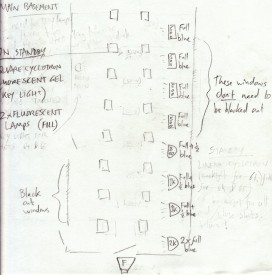
However, the best-laid plans of mice and men gang aft agley, and they ganged a bit agley in this case.
My lighting plan followed the concept I outlined in that pre-production blog post, which was to put lamps in between all the pillars on one side of the basement, representing daylight from unseen windows. Col and the runners duly set these up on the day, gelling them successively bluer along the length of the room, to enhance the feeling of depth.
However, none of the staff at the location were able to disable the fire alarm, which sadly meant we couldn’t use the smoke machine. So no cinematic shafts of light, and a blow to my second method of showcasing the fantastic depth of the location. (Possibly if we had warned them in advance about the smoke they could have found out how to disable the alarm. Oh well, lesson learnt.)
The third way I wanted to create depth was by turning off alternating fluorescent tubes on the ceiling, so that every other pillar would be in darkness. In the final analysis it seemed pointless to do this, as many of the tubes were on the blink anyway and so there were already plenty of shadows. One of the tubes kept flickering, which was a nice little touch.
I went with a tungsten white balance, which gave the greenest look to the fluorescent tubes. (On a side note, I find my 20mm Sigma registers this green spike much more than my other lenses.) Since the “daylight” was blue, I had created a colour scheme that had no contrast at all, being all cool. This despite all my previz and planning. Yes, I am an idiot.
Looking at the rushes again now, I see that despite using the Sigma lens, the fluorescent light has come out quite yellow, so there is a bit of colour contrast after all. Dumb luck: 1, Neil’s skill: 0.
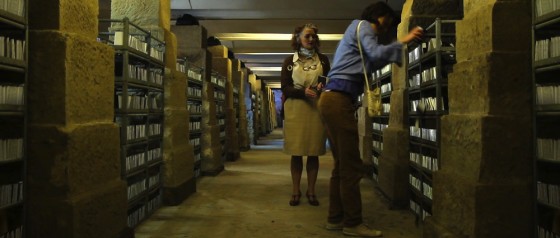
It will be fine when it’s graded, but it could have been so much better if only we could have used smoke.
Next up was a tracking-two shot over the shelves. I chose to shoot this from the opposite side of the basement to the “daylight” lamps, so that they would backlight the talent rather than giving us flat, boring front-light. We cheated the positions of two of these lamps massively so that they would both hit Kate (Georgina Sherrington) and Alice (Therese Collins) without being in shot.
Some front-light was required, because the overhead tubes weren’t lighting the ladies sufficiently or giving a very flattering look. So we rigged a fluorescent studio light over the camera. This isn’t generally a good place to put a lamp, but when you’ve got some good backlight going on you can get away with some flatness elsewhere. Ironically, this fluroescent lamp – which had a daylight-balanced bulb – needed fluorescent gel on it to get the green look I wanted, to suggest the light was coming from the overhead tubes.
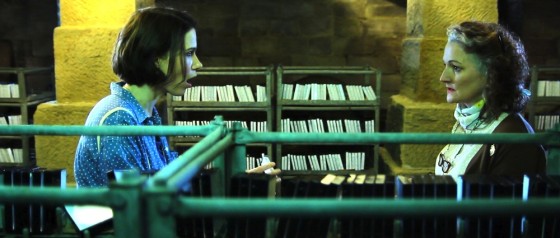
The basement was one of the few scenes in Stop/Eject in which moody close-ups with dark, unfilled shadows were justified.
One of the blue-gelled 800W Arrilites which had served as backlight in the two-shot now acted as Alice’s key. The edge-light on her hair comes from one of the overhead tubes.
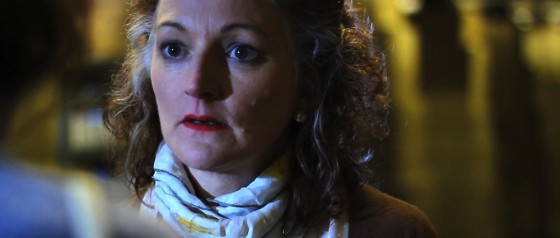
Another of those backlights became a key for Kate’s close-up. The yellowish fill is from the overhead tubes, while backlight is from another blue-gelled Arrilite positioned in a way that bore no resemblance to any previous lighting. (When you’re pushed for time as a DP, you often have to chose between making it look good or maintaining lighting continuity.)
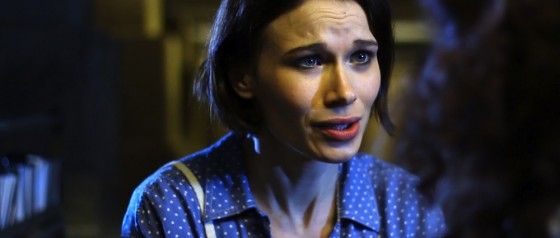
Incidentally, the trio of shots we’ve just covered – the two-shot and the corresponding singles – conform roughly to a lighting template I call “cross-backlighting”. This model consists of two backlights in the two-shot, one out of each side of frame, one of which immediately becomes a key for each close-up. There’s more info on cross-backlighting in The Ten Minute Lighting Masterclass, one of the bonus features you get when you rent the deluxe package of Going to Hell: The Making of Soul Searcher.
That brings the Stop/Eject lighting breakdown to a close. I hope you’ve found it useful. I’m more than happy to answer any lighting questions here in the comments or on the Stop/Eject Facebook page.
The next public reward is Sophie’s great little podcast about the first day of the shoot, which will go online when we reach £400, so be sure to visit stopejectmovie.com and help us get there. Thanks everyone!